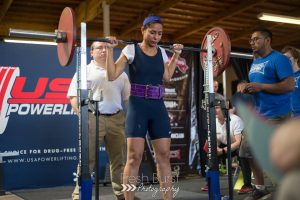A few weeks ago, I got together with one of my powerlifting friends and discussed all the valuable things we learning during that season in our lives. We reminisced about how strong we were, how fun competing was and how simple and intentional each workout was.
 Within that simplicity we made the biggest gains in our strength, technique, muscle mass, and more. While I can attribute this to a number of training variables like using deficits and chains , the most profound programming tweak for me was from percentage-based training.
Within that simplicity we made the biggest gains in our strength, technique, muscle mass, and more. While I can attribute this to a number of training variables like using deficits and chains , the most profound programming tweak for me was from percentage-based training.
Before I used percentages, I did what most people do when they lift: I added more weight to the bar each set. At the time, I had no idea what my 1-rep max (1RM) in any lift was, and I was never quite sure if I was lifting enough or too much on any given day.
This method was fine for me as a beginner, but when I was ready to advance and jump into barbell sports, percentage-based training made all the difference in my strength and aesthetics.
But first, what the heck is percentage-based training?
Percentage-based training uses your 1RM in a compound lift to calculate how much load to use within a given exercise and training day. It’s easy math and effective AF to train this way (ask any Olympic weightlifter or powerlifter) because it keeps you lifting at just the right amount at any time.
Here are just a few pros to using percentages in your workouts:
Clear-cut structure
The greatest perk to percentage-based training is that it eliminates the guesswork around weight selection. Instead of guesstimating how much to lift that day or blindly adding more weight to the bar like I used to do, percentages tell you exactly how much to lift and when.
There is a science to it too, developed by USSR weightlifting coach A.S. Prilepin and arugably the most successful weightlifting coaches in Russian history. For more on how Prilepin developed his athletes, TrainHeroic has an awesome article about it, and where I borrowed this nifty chart from:
Training with Percentages: Prilepin’s Chart
| PRILEPIN’S CHART | |||
| PERCENT | REPS/SETS |
OPTIMAL # REPS |
RANGE |
| 55% | 3-6 REPS | 30 REPS | 18-30 REPS |
| 60% | 3-6 REPS | 26 REPS | 18-30 REPS |
| 65% | 3-6 REPS | 24 REPS | 18-30 REPS |
| 70% | 3-6 REPS | 20 REPS | 12-24 REPS |
| 75% | 3-6 REPS | 18 REPS | 12-24 REPS |
| 80% | 2-4 REPS | 15 REPS | 10-20 REPS |
| 85% | 2-4 REPS | 12 REPS | 10-20 REPS |
| 90% | 1-2 REPS | 6 REPS | 4-10 REPS |
| 90% + | 1-2 REPS | 3 REPS | 2-4 REPS |
At a glance, the chart demonstrates how much volume you can handle within a certain percentage. This is key for programming because obviously, you can’t train effectively or safely lift at 80%+ for multiple reps per set or else your performance, technique, and strength diminshes.
Using percentages gave me structure and set guidelines. With that, I knew that if a week called for 90% lifts, I would likely need to rest more, eat better, and allocate more time in the gym. I also knew that if I happened to feel kind of crappy on a day that called for 80%+, I would most likely have to keep my volume on the low, low end (10 reps total instead of 20 reps total per the chart above).
Get strong faster, with less exercises
The second biggest reason to start using percentages is to get stronger a lot faster, by doing way less.
Going back to my powerlifting training, a typical workout looked like this:
1a) Front Squat with 2-sec pause: 50%x8, 60%x6, 70%x4, 74%x2, 78%x1, 82%x 1 for 2 sets
2a) Close grip bench with pause: 40%x5, 50%x3, 60%x 2 for 4 sets
3a) Dumbbell Incline press (with light weight): 3×8
4a) Core exercise: 3×8
Pretty unremarkable if you ask me. But by utilizing percentages with each of those big lifts, I was able to work in the exact range I needed to without beating my body to the ground and possibly ending up with an injury.
It also eliminated the need to do 8-10 exercises per workout at a high volume, which is typical of the bodybuilding structure (again, that’s for a different goal. Doesn’t mean it’s wrong).
You don’t have to train in a barbell sport to take advantage of this either. Percentage-based training just a more efficient and more powerful way to train, build muscle, get strong, and crush your workouts without it crushing you.
It’s measurable and manageable
As Coach Tony Bonvechio has pointed out many times before: Using percentages makes it a lot easier to track and manage your training. Going by “feel” each time you lift doesn’t always get you where you want to go, and training at the “right” volume and intensity at any given time means you have a way to track what you’re doing and see if it’s working.
Training at submaximal loads of around 60-70% is usually where we make the most gains in strength. In order to know if you’re training at that range, then you actually need to track and measure your workouts!
As you progress in your strength training, your 1RM will also improve, meaning you’ll need to re-test your 1RM at some point (every 4-6 weeks) to ensure you’re training at the right percentages. From a coach’s perspective, this makes programming a lot more manageable, and from a trainee’s point of view, you have an easy way to track and measure your lifts, see what’s working for you and what isn’t.
The drawback
Obviously, there are some drawbacks with percentage-based trainging, most of which have been discussed at length by every strength coach on the planet.
The main drawback about percentage-based training is that there’s not enough wiggle-room for the lifter if he or she is feeling great or lousy. For example, if you feel like crap on a day that calls for 90%, there’s a good chance you won’t make your lift. Or, let’s say you have to work your way up to 85% on a day you’ve had little sleep and are just not feeling it. You miss your first three lifts and then what? Do you keep working your way up to 85% even though you missed them at 70%? Do you risk getting injury just because your program told you to work with a specific load?
In these cases, I tell myself exactly what I tell my clients. Listen to your body. You can’t force a good lift. You have to practice it, and if the body is clearly not having it, it’s either the day to scale back or rest completely.
Unfortunately, not everyone will do this. They’ll either try to push through if they feel crappy, or if they’re feeling great on a 65% lifting day, they’ll likely attempt heavier lifts. I get it, I’ve done this, and I don’t recommend going off plan too much. Still, listening to your body is a practice and percentage-based training can feel a tad too restrictive for those that haven’t quite mastered it.
When to start using percentages
If you think about it, very few general population clients will benefit from percentage-based training because
1) It’s likely unnecessary for their goals
2) They likely only lift when they see you
3) You have to take into account that you’ll need to test their 1RM every few weeks.
Testing one’s 1RM is not a one and done thing. There are a number of factors to take into consideration like how the client is feeling that day, having a really good warm-up, doing a bunch of warm-up and working sets to build them up safely for that 1RM test, and the 2-5 minutes between lifts for rest. If the session is an hour long, as it is in most gyms, it’s not a good use of anyone’s time to spend it testing a 1RM. In order to work around that for the few handful of clients that do need percentage-based workouts, I work off their best, most recent PR.
However, my 1:1 online coaching clients do eventually work with percentages, assuming they’ve demonstrated the experience, skills, and technique needed to properly execute the exercises. I love it because I can measure how they’re doing and they love it because it holds them accountable.
Want to take the guesswork out of your training, get stronger, and stay out of pain? Join me for BarbellSTRONG 1:1 customized coaching. Learn more

